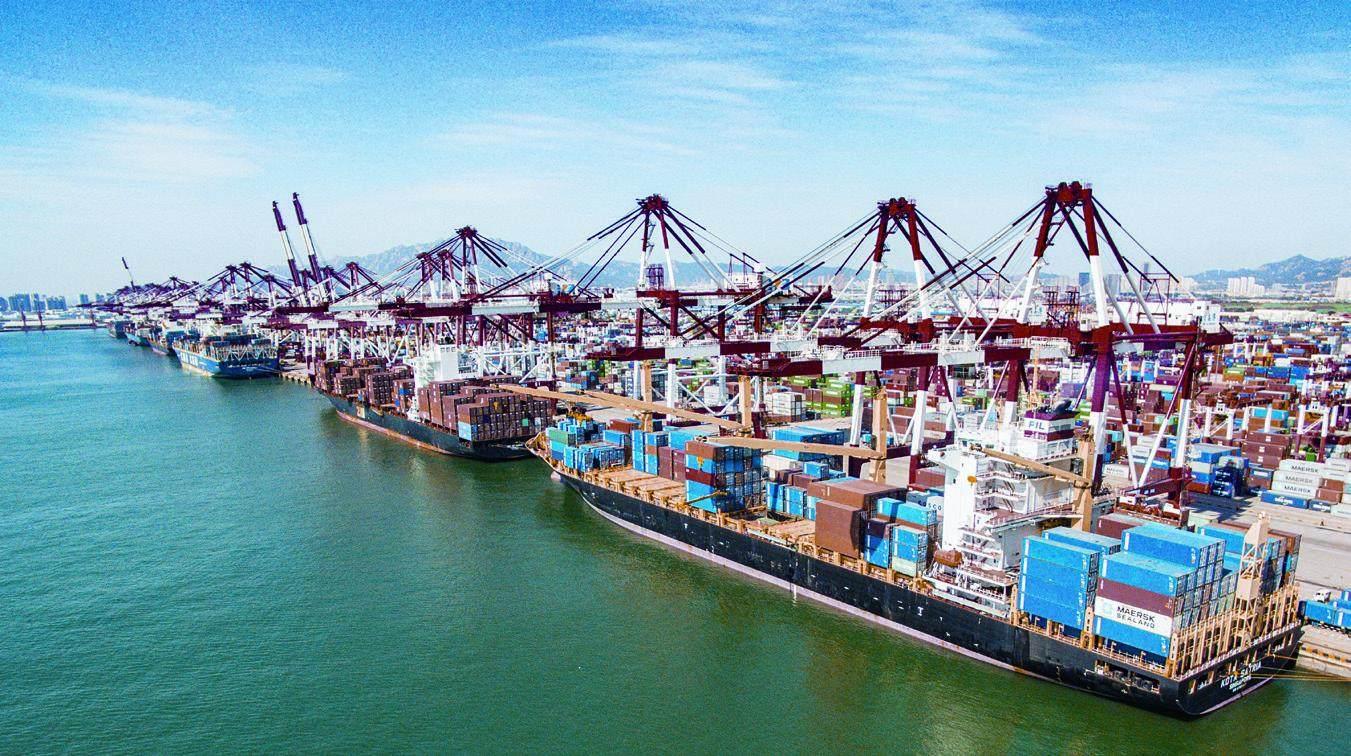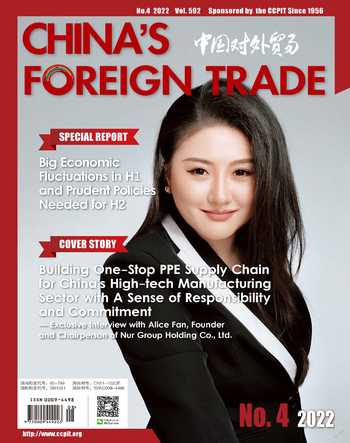RCEP Enhances Bilateral Cooperation Between China and South Korea
By Liu Xinwei


Recently, the Department of Interna- tional Cooperation of the National Development and Reform Commission and KOTRA jointly organized the 2022 China-South Korea Economic and Trade Cooperation Conference and the ChinaSouth Korea Economic and Trade Cooperation Forum (the Conference) to discuss new models for cooperation between China and South Korea and seek out business cooperation for manufacturing (new energy vehicles, electromechanical electronic products, IT, and medical), as well as in raw materials, parts, equipment and other sectors.
At the opening ceremony of the Conference, KOTRA President Yu Jeoung–yeal delivered the opening speech in a video message, and said that, thanks to the mutually beneficial cooperation between China and South Korea, China-South Korea trade had achieved remarkable results over the last three decades, accurately reflecting the consistently close partnership between the two countries. Standing at a new starting point, this event was expected to open up new horizons for the economic cooperation between the governments of and enterprises in China and South Korea.
China and South Korea press the button to start a new era
Both geographically and historically, China and South Korea have been close neighbors and one of the most important economic partners to each other over the years. Despite the current background of the continued spread of the COVID–19 pandemic and the global supply chain growing even more unstable, the bilateral trade volume between China and South Korea reached a historical new high in 2021, topping USD 360 billion, which was 72 times higher than that in the year when China and South Korea established diplomatic ties between the two countries.
“As a pillar supporting the development of relations between the two countries, we need to firmly promote economic cooperation between the two countries, in order to achieve a winwin situation,” Yuh Pok–keun, economic minister of the Embassy of the Republic of Korea in China, stated at the Conference.
In recent years, China has carried out a strategy to promote all-round opening up at a higher level in the new era, to boost high quality development by expanding financial openness, and to strengthen international cooperation in terms of production capacity. Li Mingxing, a member of the National Committee of the Chinese Peoples Political Consultative Conference and Vice President of the China Enterprise Confederation, said, at the Conference, that multilevel organic cooperation between China and South Korea regarding the production capacity will hopefully create new momentum for the development of the cross-border production capacity and new trends toward synergistic industrial innovations in China and South Korea.
“China and South Korea are permanent geographic neighbors and inseparable partners. Taking the 30th anniversary of establishing diplomatic relations as an opportunity, China and South Korea should actively extend the scope of their cooperation and make new contributions to two-way investment and high quality development,” said Li Yong, Deputy Director of the Investment Promotion Bureau of the Ministry of Commerce, at the Conference.
At the Conference, eight leaders from China and South Korea jointly pressed the button to start the Conference, marking the beginning of a new era of economic and trade cooperation and regional economic co-development and coconstruction between the two countries.
In three chapters entitled “Looking Back and Forward”, “Unfolding the New Era” and“Joining Hands on a New Journey”, the Conference reviewed the tremendous achievements in economic and trade cooperation over the last 30 years between China and South Korea, and discussed current international issues, including supply chain reshaping, “challenges” and“opportunities” caused by carbon neutrality, and the implementation plans for the RCEP, providing suggestions to further deepen cooperation between the two countries in various fields such as industry, trade, and investment.
As part of the Conference, the “2022 China–South Korea New Energy Vehicle Coop-eration Forum” and “2022 China-South Korea Exchange Meeting for Biomedical Industry and Technology Cooperation” were held. KDemo Day, entitled the “Integration between ICT and Environment”, an innovative roadshow for South Korean innovative companies, was welcomed by many Chinese and South Korean IT companies. In the area of “Business Negotiation and Exhibition”, representatives from both Chinese and South Korean companies actively engaged in cooperation negotiations, and promotional booths were set up by outstanding enterprises from South Korean high tech industries as well as major Chinese institutions and local governments.
Hong Chang–pyo, Chief Representative of KOTRA China, said, “I hope the Conference will build a platform for friendly exchange and cooperation between China and South Korea, and make positive contributions to strengthening and deepening the economic and trade development between the two countries.”
South Korea is facing a challenging internal and external environment for its economy
At the new government briefing to clarify the direction of economic policies, the president-elect of South Korea, Yoon Suk–yeol, said that South Korea was facing a comprehensive crisis and a tough domestic and international environment for its economy, as a weak economy and rising prices were causing a rising possibility of stagnation, placing great pressure on both economic and market stability.
In early June, Russia announced restrictions on the export of inert gas, which is an indispensable raw material in chip manufacturing. Some media outlets believed that South Korea would be impacted the most. South Korea has been highly dependent on inert gas imports, and unlike the United States, Europe, Japan, and other countries that can adequately cope with the Russian sanctions, there is no plant in South Korea that can increase the production of inert gas.
The report entitled Impact of the Ukraine Crisis on the EU Economy and South KoreaEurope Trade, issued by the Economic Research Institution and International Department of the Bank of Korea (the South Korean central bank), stated that exports from South Korea to Europe were mainly affected by local demand and the economic growth rate in Europe. Specifically, if the EU records an economic growth rate of minus 1% due to the crisis in Ukraine, then the nominal export value of South Korea to Europe will decrease by 2.1% to 3.2% accordingly.
In the digital sector, a survey by the Korea Economic Institute (KEI) indicated that South Korea has a digital economy potential at the top level among OECD countries, but companies had a low ranking for their ability to use digital technology. In the energy sector, EMBER, a British climate think tank, reported that wind and solar power only contributed 4.67% of South Korean electric energy production, less than half of the global average, meaning that South Korea is lagging behind in energy transition. Climate solutions researcher Justin Holmes highlighted the fact that South Korea would have a long way to go in terms of energy transition, and the new administration should formulate an effective plan to push consumers to get used to renewable energy, while also making progress on the target of abolishing coal-based power plants by 2030.
In response to these economic problems, the new government of South Korea introduced the “Direction for Economic Policies of the New Government”, proposing to foster new industries and support related scientific and technological research and development. Specifically, South Korea plans to develop strategies for new industries and detailed programs to support industrial and technological development, and to formulate a “Basic Plan for Advanced National Strategic Industries” to enhance the technology and production capacity of strategic sectors related to economic security including the semiconductor industry. Second, South Korea is to construct supporting infrastructure for the development of sunrise industries such as AI, biology, and robotics, as well as a biomanufacturing engineering innovation center by 2025 using big data and AI technologies, and late this year or early next year, will also introduce a basic plan to support these sunrise industries such as aerospace, robotics, and nano technology. Besides this, South Korea tends to create a favorable environment for scientific and technological research and development in emerging industries. South Korea will unveil the Fifth Science and Technology Basic Plan this November, and will promulgate a Special Act on National Strategic Technology Cultivation and the roadmaps for strategic technologies, in order to ensure the development of irreplaceable upstream technologies in the fields of economics, diplomacy, security and so on.
RCEP broadens and deepens the economic and trade cooperation between China and South Korea
On February 1st, the RCEP officially took effect for South Korea. From January to May this year, the trade volume between China and South Korea reached USD 152.26 billion, up 10.2% year-on-year, reflecting the role of the RCEP as a booster and demonstrating the resilience of and the potential of economic and trade cooperation between the two countries.
“RCEP members are economies at different stages of development, ranging from high income countries to middle-income and lower-middle income countries. As an inclusive agreement, the RCEP will spur on a comprehensive transformation and upgrade of regional economic and trade models, turning the member countries and regions into a new engine of global economic growth,” Yu Jeoung–yeal said.
“We need to actively educate the industry with the detailed RCEP and help enterprises benefit from the implementation of the agreement as early as possible. As an international trade and investment promotion agency, KOTRA recently distributed free RCEP practice guides to South Korean companies, to help the industry better understand the RCEP,” continued Yu Jeoung–yeal.
According to the research report of the“Major Expected Effects of RCEP” by the Institute for International Trade of the Korea International Trade Association (KITA), as the RCEP comes into effect, South Korean enterprises are expected to have comparative advantages over Japanese ones in the sectors of plastics and synthetic resins, over Chinese ones in medical devices and video machine parts, over Vietnamese ones in auto parts and steel, and over those in Indonesia, Thailand and the Philippines in cultural content and distribution.
Many South Korean experts believed that the RCEP would further tighten the relationship between China and South Korea and make the proportion of zero tariff goods account for 86% of bilateral trade in goods between the two countries.
At almost the same time as the RCEP took effect on February 1st, 2022, Qingdao Customs issued the first RCEP certificate of origin for a batch of jeans to be exported to South Korea. According to Bi Haijun, Director of the Tariff Department of Qingdao Customs, after the RCEP came into effect for Korea, Chinese enterprises can export certain types of clothing, starch dextrin, shortening and other products with certificates of origin to South Korea at a lower tariff rate, while importing electric motors and vehicle parts from South Korea at a significantly reduced tariff rate.
In addition to RCEP, there are several other FTAs between China and South Korea, and therefore multiple agreements may be applicable to one specific commodity. Bi Haijun suggested that enterprises should do a good job in comparing tariff reductions offered by various agreements, then select the right agreement and apply for the required certificates. Customs can also be helpful in designing schemes for the RCEP, so as to ensure that enterprises can mostly benefit from the RCEP.
Cui Lin, Deputy Director of the International Cooperation Center of the National Development and Reform Commission, said at the Conference, following the trend of economic globalization, China and South Korea should grasp this historical opportunity as the RCEP took effect, consolidate the “grounds” for cooperation, improve the “fruits” of cooperation, explore new paths and models for economic and trade cooperation between China and South Korea, and upgrade and secure stable, sustainable and high quality cooperation between the two countries.
- China’s foreign Trade的其它文章
- Zero Tolerance for Bad Faith Trademarks By Chinese Authorities
- Focus on Seven Aspects of the Amendments to the Anti-Monopoly Law
- Off-shore Duty-free Consumption in Hainan Surges
- New Infrastructure Construction Promotes the Stable Growth of the Chinese Economy
- China’s Automobile Exports Catch Up from Behind
- The Logistics Industry Turns Positive

